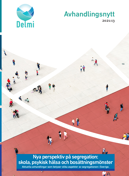The aim of this literature review is to analyse research on the role of the built environment in addressing segregation and unequal living conditions in Swedish cities. Through a systematic search in various scientific databases, 1,624 studies were screened. After filtering out irrelevant results, 48 studies were included. The review's findings, conclusions, and policy recommendations are based on a synthesis and analysis of these studies.
Some overall conclusions and recommendations
- Developing a more connected urban structure: Enhancing connections between neighborhoods and strengthening the integration of key thoroughfares within the city's overall structure can influence mobility patterns and increase social interaction.
- Increasing diversity in housing supply and tenure forms: To combat socio-economic segregation, a mix of housing tenure types and unit sizes should be promoted in both existing and new residential areas.
- Designing public spaces as social hubs: Identifying and developing strategic meeting places within the urban space can strengthen social interaction between different societal groups.
- Ensuring equitable access to urban resources: A fairer distribution of workplaces, services, cultural institutions, and educational opportunities across different areas is crucial to reducing segregation and creating equal living conditions.
- Implementing long-term and structural measures: Segregation issues should be addressed through a combination of housing policy initiatives and urban planning, rather than solely through targeted interventions in specific neighborhoods.
- Further research on the role of urban spaces in segregation: To better understand the mechanisms of segregation, additional studies that combine analyses of the built environment, mobility patterns, and social interactions are needed.
About the authors
Lars Marcus, Professor, Urban Design and Planning, Architecture and Civil Engineering at Chalmers University of Technology. Ann Legeby, Professor of Applied Urban Design at the School of Architecture, KTH Royal Institute of Technology.
Published: April 8th 2025
Photographer: CHUTTERSNAP on Unsplash


